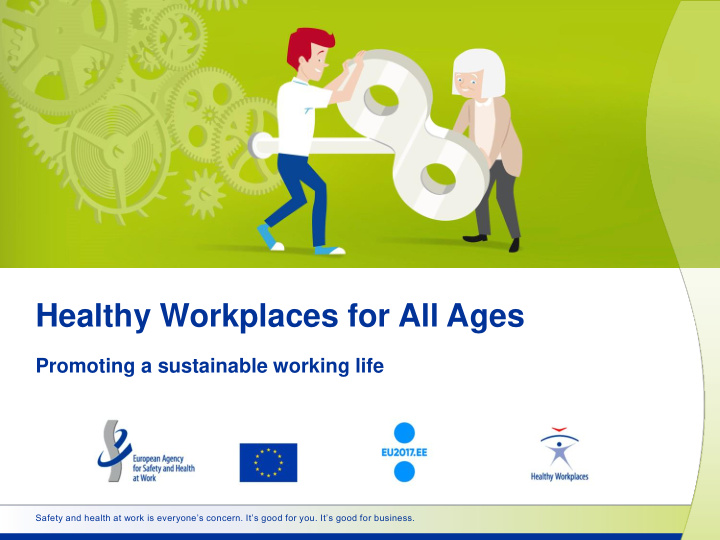



Healthy Workplaces for All Ages Promoting a sustainable working life Safety and health at work is everyone’s concern. It’s good for you. It’s good for business.
Good Practice in Age Management & OSH Stephen Bevan, Institute for Employment Studies Honorary Professor, Lancaster University Chair of Good Practice Awards Jury Safety and health at work is everyone’s concern. It’s good for you. It’s good for business.
Older Workers in the Labour Market Labour market participation of people aged 55-64 years old is growing - increasing the proportion of ‘older workers’ in the workforce The employment rate among people aged 55 – 64 in the EU grew by almost 15 percentage points between 2000 and 2014 - faster than other age groups Projections suggest that the employment rate for older people, in particular for women, will continue to rise across Europe during the next 50 years, reaching 67% by 2060 Policy-makers are attaching increasing priority to ‘extending working lives’ to improve the sustainability of social welfare systems and because remaining in good quality work can have therapeutic benefits for older workers 3
Rising Economic Activity Levels 4
Age & Co-morbidity 50% Three or more long-term health conditions 45% Two long-term health conditions 40% Proportion of population 35% One long-term health condition 30% 25% 20% 15% 10% 5% 0% 18-24 25-49 50-SPa Age group Source: Labour Force Survey 3 quarter average 2013Q2-Q4 5
Ageing, Health & Work No long-term health condition Diabetes Heart, blood pressure or blood circulation problems Chest or breathing problems, asthma, bronchitis Digestive problems Other long-term health conditons Musculoskeletal problems Depression Mental health conditions 0% 10% 20% 30% 40% 50% 60% 70% 80% 90% Source: Labour Force Survey 3 quarter average 2013 Q2-Q4 Employment rate 6
Action by Employers Employers are concerned to retain know-how and prevent skill shortages threatening efficiency & productivity – also need to consider novel approaches to job retention and adaptations which accommodate the demands of an ‘age - diverse’ workforce A key focus for the 2016- 2017 ‘Healthy Workplaces for All Ages’ campaign 7
Good Practice Awards The Good Practice Awards 2016-17 aim to recognise companies / organisations actively managing safety and health at work in the context of an ageing workforce. The entries had to demonstrate a life-course perspective to risk prevention to ensure healthy ageing at work, a holistic approach to OSH management, consideration for age diversity, diversity- sensitive risk assessment followed by workplace adaptation, possibly also measures for return to work. 42 entries from 23 countries, five entries were received from official campaign partners. The awards were judged by a European jury, including representatives from EU-OSHA, the Directorate General for Employment, Social Affairs and Inclusion, the European Trade Union Institute (ETUI), the Confederation of German Employers ’ Associations, and the Maltese Occupational Health and Safety Authority. The jury was chaired by Prof. Stephen Bevan. Eight entries were awarded and eight commended, one of the official campaign partner entries was awarded and one commended. 8
Good Practices – success factors Clear business rationale for action Getting senior management support – ‘hearts & minds’ Risk and needs assessment, conducted in a participative manner Interventions focused on prevention - with a traditional OSH perspective but with a strong appreciation of the need for a positive psychosocial work environment Interventions focusing on Work Ability – job redesign Active worker ‘voice’ and involvement in design and implementation Clear evaluation of impact Capturing the learning from interventions Multi-sector entrants, from large and small employers and from multi-national businesses to those with limited resources 9
Innovative elements Heidelberger Druckmaschinen, Germany Demand orientation, not HR driven but by departments themselves, looking at needs and concerns of employees Workers participation: worker’s council, HR, top management in thesteering group, support from union and employer’s association Broad range of stakeholders involved: OSH department, medical services, various HR departments Zumtobel GmbH, Austria Optimized process for return to work/rehabilitation: full pay for soft return 12 weeks, integration team support, psychological support for mental illness Federation of Finnish Technology Industries Thorough evaluation of results: work well-being index, work ability index, satisfaction with management, sickness absence 10
Innovative elements Region Midtjylland (Central Denmark Region, ersponsible fo health care and hospitals) Denmark Comprehensive measures to reduce the risk of injury from patient transfer Design guides specifying building requirements for construction and conversion projects, such as for bathrooms, scanner rooms, bedrooms and operating rooms, so that there is room for storing assistive devices and space to perform patient transfers. Rudnik- Mine, Serbia Difficult sector with physically and mentally demanding jobs Training system for miners, training of new workers by experienced ones, group trainings by occupations/duties, 11
Innovative elements Loders Croklaan, Netherlands To reduce the risks related to shift work, part-time work and job sharing were introduced. Allowing employees to work part-time gives them longer recovery periods between shifts Internal traineeship: employees can apply for internal traineeships to acquire knowledge in other areas and to gain the necessary skills to change jobs within the company. Duslo a. s. Slovakia Day care centre for elderly to support workers with care responsibilities Vassiliko Cyprus To reduce the increased risks of shift work for older workers, the company increased the number of shifts from four to five by employing 15 new workers, allowing employees longer rest periods between shifts. 12
Areas for Improvement? Risk assessment From a ‘deficit’ - based to a capability’ -based perspective on work accommodations Focus on physical health and physical function – less on psychosocial health or cognitive function Little on early intervention and referral to OH professionals in order to prioritise effective job retention Vocational Rehabilitation is recognised but few included tailored approaches to redesigning work in a way which matches job demands with worker resources (‘Work Ability’) Weak evidence base for some interventions Few interventions to improve line manager capability (RTW & VR) Little on self-management by workers with health conditions – can improve job retention and productivity Lack of formal evaluation 13
www.employment-studies.co.uk Stephen.bevan@employment-studies.co.uk @StephenBevan @EmploymtStudies 14
Recommend
More recommend